III.Bio-Diversity Reconstruction
RESTORING JAPAN'S RIVERS TO ECOLOGICAL VIBRANCE
|
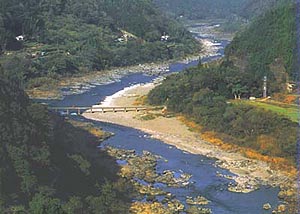
| The Shimanto river (Kochi Pref.,Shikoku) is one of the last great rivers which largely maintains its natural form. Neo-natural river reconstruction is promoted there. |
|
NEO-NATURAL RIVER RECONSTRUCTION IN JAPAN
The wetland environment, consisting of rivers and marshes, is the richest of natural environments:of all ecosystems, the wetland has by far the most small animal species, from plankton and algae to fish and birds. Historically, human development has abused the wetlands, even when the development had the appearance of supportive reconstruction.
The damage has been done; what can man do to provide for a restoration of ecological systems when elements of the environment have disappeared, when species are extinct? One promising answer lies in the technique of "neo-natural river reconstruction", developed since the mid-1980s in western Europe. Neonatural river reconstruction consists of the introduction of various species of flora and fauna into a river environment, not with the intent of recreating the organic ecosystem that has deteriorated at the hand of man, but creating a new ecosystem which protects the surviving inhabitants, restores ecological balance and improves the living situation of animal and plant life.
"Biotop" is a German word used to describe the smallest ecological unit which will sustain an environmental balance. Neo-natural river reconstruction hinges on the idea of providing a situation where a biotop can develop, where a harmonious relationship between nature and man can flourish, supplanting the antagonist relationship underlying crude urbanization. The Japanese have undertaken an extensive positive examination of this European alternative to the usual river repair work and "landscape preservation".
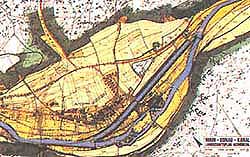

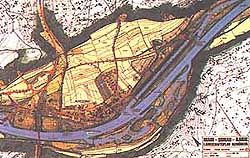
River Repair and Maintenance in Altmuhl,Germany. Before the repair work and after.
|
|
THE DAWNING OF RIVER CONSCIOUSNESS : GERMANY
With urbanization and industrialization, the number of animal species in the world has decreased markedly. This became vividly, painfully clear in the early 1980s. In Germany, as in other industrialized, urbanized countries,forests had been cleared in order to create living space and agricultural land and to improve roads and canals. Even in areas of Germany which remained forested, intensive economic utilization of land continued apace in the form of tree harvesting, single-species reforestation to replace harvested multi-species natural forest, and "reclamation" of lakes and swamps. These influences, along with industrialization and intensive agriculture, had worsened the plight of natural systems. The ecological balance of plants and animals in clean rivers collapsed. Animal and plant species disappeared from the rivers, which were now lined with concrete. In Bayern alone, 560 out of 2,030 species of plants including ferns were reported to have disappeared by 1983, and only 25% of the 35,000 native animal species of that state survive today. Of course even in nature species change places in the evolutionary course of events, but this catastrophic decimation of species happened in an alarmingly short time, and the people of Bayern were convinced that this disappearance of species could well threaten human existence too. An effort was mounted to prevent the loss of more species of flora and fauna, and to create a new, supportive living space for a range of plants and animals. This was the origin of the concept of neo-natural river reconstruction.
THE ORIGN OF NEO-NATURAL RIVER RECONSTRUCTION
In 1984 the state of Bayern amended its constitution with a radical new objective: protecting the vital foundation of nature, and obliging the populace to work towards preserving balance in natural systems, and to systematically improving the environment by preserving indigenous species and their living space. Proponents of the revitalization of German river ecosystems began to promote the underlying principles of neo-natural river construction in the early 1980s, and these principles were applied to many rivers, mainly in former West Germany.
|
|
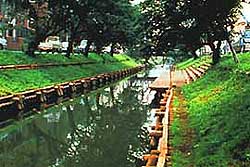
The Shingashi River (Saitama Pref.), a branch of the Ara River system. Putting "mokko-chinsho", an arrangement of logs in parallel crosses with stones inside, along the river's edge in order to preserve the environment for fish. This also harmonizes with the trees on the bank. The Tsutsumizawa River (Niigata Pref.), a branch of the Ara River system. A brushwood fence along the low banks protects life in the nearby water. Pebbles and gravel fill the gap between the fence and the bank.
|
|
PRINCIPLES OF NEO-NATURAL RIVER RECONSTRUCTION
In Bayern, various trial generations of biotop (the smallest self-sustaining and integrated unit of biological space) in river environments were carried out.The policy elements of Bayern's river reconstitution projects were as follows:
- A river basin, including the farmland intended as flood control must be regarded as an ecological complex, and must be the focus of an entire maintenance project.
- Pre-existing species of flora and fauna should be preserved to the greatest possible extent, and species diversity in the ecosystem should be enhanced.
- The characteristics of each species'habitat should be developed in harmony with the natural dynamic alterations that take place in a river, such as erosion, sedimentation, and floods.
- The unique character of each river should be determined by a balance of natural and human influences according to the condition of the surroundings.
- Profound consideration must be given to consistent maintenance of the natural habitat and its unique characteristics.
- Given the length of time required to create a new biotop, it is essential to first preserve what remains of the original biostructure.
- Repair and maintenance should be done in harmony with ecological rhythms and cycles.
- New planting technology must be incorporated into traditional civil engineering techniques.
- Any plan to reconstruct a natural river environment must afford space sufficient to the dictates of ecological system requirements.
The German perspective sees river reconstruction as an artful agent of human peace of mind, as well as a way of moderating climate and creating a more pleasing and functional landscape.
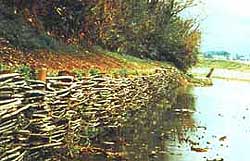
|
The Tsutsumizawa River (Niigata Pref.), a branch of the Ara River system. A brushwood fence along the low banks protects life in the nearby water. Pebbles and gravel fill the gap between the fence and the bank.
|
|
RIVER RRCONSTRUCTION IN JAPAN
The Japanese quite promptly took up the European example and examined the possibility of the concept of neo natural river banks in Japan. Theexample set in Bayern was the mostinfluential when biodiversityreconstruction was considered for application in Japan. One outstanding example is the Shimanto River in Shikoku, and many other examples may be found around the country.
There is, however, a need for further research in this field in Japan. Given the wide variation of character in the rivers of the world, facile comparison is to be avoided. However, it could be said in fairness that, compared with the detailed policy of Bayern in Germany, Japanese river reconstruction projects are still limited to unsophisticated bank protection work.
The Shimanto River in Shikoku is an example of careful reconstruction. Plant habitats along the banks of Japanese rivers vary with the climate, the section of the river (upper, middle and lower reaches), the terrain, and the population of animal species. For instance, in the middle and upper reaches of rivers in the Chugoku region, in Shikoku and northern Kyushu, such distinctive flora as pussy willows, rhododendrons, miscanthus, alder and some types of oak may be found. With this fact in mind, rhododendrons were chosen for planting along the Shimanto River as part of the neo-natural river reconstruction project there.

|
The Hirose River (Miyagi Pref.). a branch of the Natori River system. An example of putting "futon kago", a kind of wooden hamper, along the lower banks. Turf is placed behind the futon kago, and big stones are placed alongside to create a fish habitat.
|
|
REVOLUTIONIZING JAPANESE RIVER RECONSTRUCTION
Further research is still needed in this field in Japan, in particular with regard to 1) maintenance and utilization of the existing habitat in proximity to rivers, and 2) development of new engineering techniques for the protection of river banks in order to keep them as close as possible to their natural state. In addition, in order to move forward from what might be called a stage of practical simulation, the people of each region of Japan should determine their own individual approach in light of their unique situation. Given the existing background of environmental concern, interdisciplinary research must be promoted in the near future; this calls for investments of money, equipment and human resources.
Since the 1960s, Germany has been promoting the development of technology for river maintenance which contains harmonious elements of both conservation and development. However it was not until quite recently that this new vision of 'sustainable development' began to be understood in Japan. There is a need in Japan for the exploration of such development/conservation technology in terms of both planning and implementation.
We humans are just one of the life forms of this planet, and like other life forms, we rely on such elements of nature as good quality soil and water, circulation of oxygen and carbon dioxide, and food resources: as such, we must enter a new age where we live carefully and humbly in the earth's limited natural system.
After five years of research and negotiation, 157 countries signed the Convention on Biological Diversity at the Earth Summit in 1992. Forty countries, including Japan, have ratified this treaty, and it came into effect on December 29, 1993. ln this light, Japan should develop its own unique blend of neo-natural river construction techniques and traditional Japanese river management methods in order to provide a good example to the world,in a spirit of international cooperation.
|
|
THE AUTHOR'S PROFILE
YUYA ASO is a landscape architecture planner.Born in 1949 in Yamagata Prefecture,he graduated from Chiba University with a master's degree in horticulture. He subsequently worked at Chiba Universily's lnstitute of Landscape Gardening and at a private consulting firm, and is now Chief Researcher and Consulting Engineer at the Foundation Systems Research and Development Institute of Japan.
Among Mr.Yuya's books are 'Midori no Keikaku'(Green Plan for Urban and Natural Parks) and "Essay on Resort Development Planning."
|
BACK






